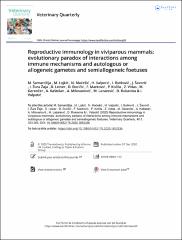Reproductive immunology in viviparous mammals: evolutionary paradox of interactions among immune mechanisms and autologous or allogeneic gametes and semiallogeneic foetuses

View/
Date
2020Author
Samardžija, M.
Lojkić, M.
Maćešić, N.
Valpotić, H.
Butković, I.
Šavorić, J.
Žura Žaja, I.
Leiner, D.
Đuričić, D.
Marković, F.
Kočila, P.
Vidas, Z.
Gerenčer, M.
Kaštelan, A.
Milovanović, Aleksandar
Lazarević, M.
Rukavina, D.
Valpotić, I.
Metadata
Show full item recordAbstract
Literally, reproductive immunology was born in bovine on-farm reproduction where seminal
experiments intended for developing methods for embryo transfer in cattle were performed.
Actually, these experiments led to two of major concepts and fundamental
principles of reproductive immunology using the bovine species as a model for biomedical
research, namely the concept of acquired immunological tolerance and the paradox
of the semiallogeneic bovine foetus whereby such organism can develop within an
immunologically competent host. Peter Medawar, a scientist who together with Frank
Macfarlande Burnet shared the 1960 Nobel Prize in physiology or medicine for discovery
of acquired immunological tolerance, while studying dizygotic cattle twins, thereby giving
birth to reproductive immunology. Also, these findings significantly influenced development
of organ transplants and showed that using farm animals as models for studying
transplantation immunology had general relevance for mammalian biology and health
including those of humans. However, the interest for further research of the fascinating
maternal immune influences on pregnancy and perinatal outcomes and of the prevention
and treatment of immunologically mediated reproductive disorders in viviparous mammals
of veterinary relevance by veterinary immunologists and reproductive clinicians have
been very scarce regarding the application of nonspecific immunomodulatory agents for
prevention and treatment of subfertility and infertility in pigs and cattle, but still broadening
knowledge in this area and hold great potential for improving such therapy in the
future. The aim of the current overview is to provide up-to-date information and explaining/
translating relevant immunology phenomena into veterinary practice for specialists
and scientists/clinicians in reproduction of animals.
